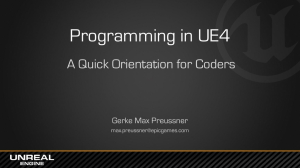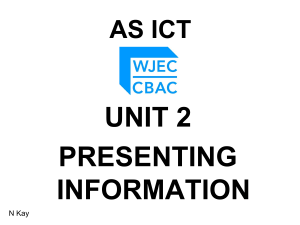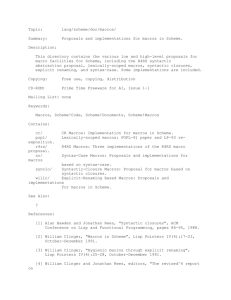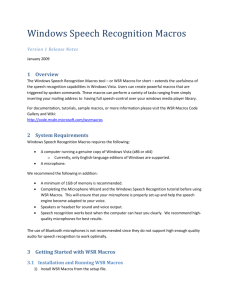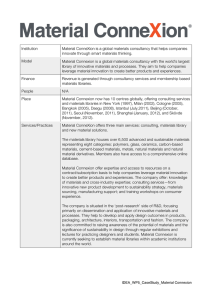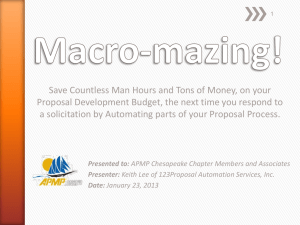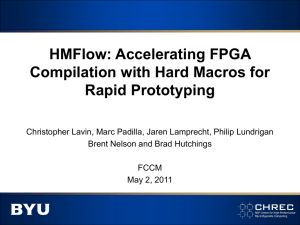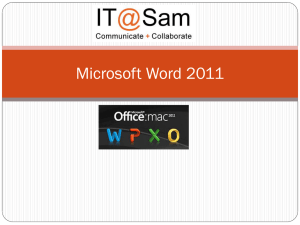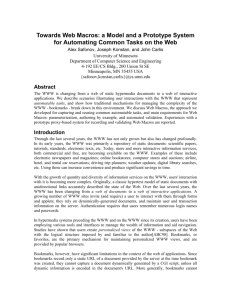connexion
advertisement
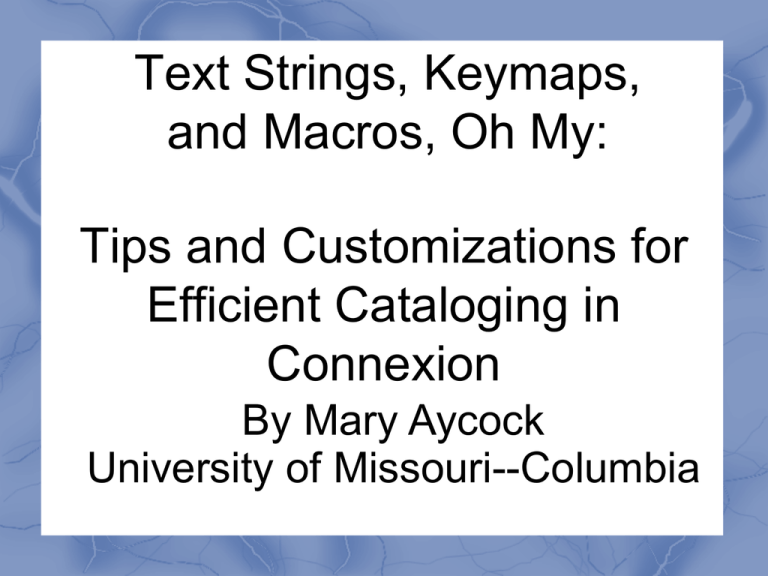
Text Strings, Keymaps, and Macros, Oh My: Tips and Customizations for Efficient Cataloging in Connexion By Mary Aycock University of Missouri--Columbia Connexion Tools Number of tools to save the cataloger keystrokes and time Why invest time to save keystrokes? Greater productivity Less tedious work Less errors Text Strings Constant Data Least Macros More Level of Complexity Cost-benefit analysis taking into account How many records require editing How extensive the edits are Complexity of the task Text Strings Often easier to use and create than constant data Use when you just need to insert consistent data in record (949s, etc.) Can assign to: User tool, keyboard shortcuts Type text strings as you would normally type fields, etc. Example: 949 strings Constant Data Unlike text strings, can code fixed fields Considered records; can save to online or local file CAUTION: Editing constant data vs. applying Can derive from a bib record Can assign from default, assign by name or from list Example: ETD brief records Macros Connexion comes equipped with built-in set of macros. Similar to other macro programs Can use “Record” option to program macros and then learn about the coding by examining the macro Cannot record mouse movements Written in OCLC macro language (OML): a modified form of Basic Macros Galore, Built-In Built in macros of general interest Add & Edit 007 Add 33x (RDA related) Insert Heading Macros Galore, External External macros of general interest Make830 (takes an existing 440 & makes into a 490/830 combination): From Walter Nickeson's site Provider Neutral macro: From PCC Site CursorJump macro (for jumping to a particular character in a field): From Walt Nickson's site CAUTION: External: create a new workbook with these Macro Demonstration Demonstration Recording a macro Example of macro code Grabbing a macro Resources for Macros Program for Cooperative Cataloging: http://www.loc.gov/catdir/pcc/macros.html OCLC macros: http://www.oclc.org/connexion/support/macros.htm Walt Nickeson’s Macros: http://docushare.lib.rochester.edu/docushare/dsweb/View/Coll ection-2556 Better Living through Macros by Joel Hahn: http://www.hahnlibrary.net/libraries/oml/index.html Joel Hahn's OML for the Complete Beginner: http://www.hahnlibrary.net/libraries/oml/lessons/index.html Keymaps Can assign keyboard equivalents (shortcut keys) to menu items, macros, characters (such as diacritics), or text strings Keymap options Organizer: Work with keymap files (advanced) Reset: buttons to original settings List All: List • all the userdefined functions Unassign: • unassign a particular keymap (yours or default) •Assign: to assign a shortcut key User tools Figures of Numbers Tools → User Tools → Assign Toolbar Customizations Tools → Toolbar Editor Then drag and drop To remove from toolbar: drag and drop back into toolbar editor Further Toolbar Customizations To move your icons around: Press Alt-click with cursor Can display on 2 lines (click on the arrow next to the toolbar) To put an extra divider: Find separator in toolbar editor window (control-S) and drag and drop To increase button size: Tools > Options and then Toolbar (must then close & reopen client) View > Toolbars to see all the toolbars Resources Connexion training: http://www.oclc.org/support/training/connexion/ Connexion tutorials: http://www.oclc.org/support/training/connexion/client/t utorial/default.htm Connexion documentation: http://www.oclc.org/support/documentation/connexion /client/basics/options/ Questions or Comments? Contact information: Mary Aycock aycockm@missouri.edu

